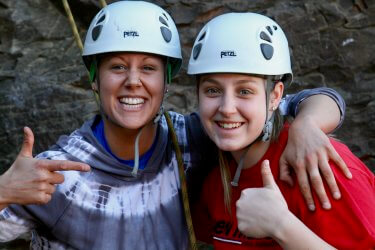We’re both inclined toward all things optimistic and tend to question the status quo. So when we came across the work and thoughts of Dewitt Jones (2017), freelance photographer for National Geographic, we were more than intrigued. Jones speaks often of the creative processes in his photography, of how a change in perspective takes his work from being good to being extraordinary. During presentations, he illustrates his point with pictures of the same subject matter, but taken from different vantage points—from different perspectives. He notes that finding the best perspective for a photograph often takes imagination and risk. He speaks of the value of creativity, of having made the mistake of stopping taking pictures when he thought he had the “right answer” only to discover that someone had taken a better picture by being creative. Thus, he is always in search of the “next right answer.”

Looking for the Next Right Answer
Some people are uneasy with the notion that there is such a thing as the next right answer—as if it nullifies the rightness of the previous right answer. Or, that giving up on what we are now doing somehow is a betrayal of our venerable past. This attitude can lead to a refusal to look forward, to move forward, to change, and to grow. But reluctance to thinking differently risks stagnancy, irrelevancy, and ultimately extinction. In contrast, we are thrilled that the possibility exists of a next right answer.
In September 1992, JOPERD published a special edition called the Critical Crossroads Report. The authors described the dilemma that the field of physical education faced and shared a conviction that if we made the right moves—found the next right answers—the profession would survive. Conversely, the authors warned that if we changed nothing, kept doing what we had always done we will have “fiddled while Rome burned!” It was a time when the brightest minds in our field were challenged to face some brutal possibilities: Either become relevant or risk disappearing entirely from our public schools. This led to a concerted effort to identify PE’s failings and barriers to its success.

A Look Back at Physical Education and the Public Health Perspective
While some remained anchored to the previous right answers, others began to re-conceptualize physical education as a public health tool (McKenzie, 2007; Pate, 2009; Sallis, 1994; Sallis et al., 1992). They argued that PE teachers were better positioned than anyone to serve as leaders in the battle for healthy and active children. Forward thinking scholars wrote of how a health promotion model could make PE relevant again, and today we have a nationwide initiative with a singular, unifying mission: 50 Million Strong by 2029. Its central message is to rally our efforts in the promotion of healthy and active lifestyles to at least 50 million of our school-age children by the year 2029. This national dialogue is bolstered by a widespread increase in healthy-living awareness. Today, it’s vital we find and study what is working and retain it while looking for the next right answers (Ward, 1999). For the profession to survive, we must reinvent ourselves (Rink, 1992).
What are Successful Programs Doing Right?
Over the past 15 years we have examined the history and functioning of a large-scale success story in public school physical education from the administrator, teacher, student, and parent perspectives (Pennington, Prusak, & Wilkinson, 2014; K. A. Prusak, Davis, Pennington, & Wilkinson, 2014; Keven A. Prusak, Pennington, Graser, Beighle, & Morgan, 2010). Four decades of success across the district began when a critical mass of like-minded professionals in key positions, came together with a single purpose—quality physical education (QPE). We learned that the collective influence of all these stakeholders canand doesshape the quality, viability, and sustainability of quality physical education.
Even in the face of nearly insurmountable obstacles (downturns in the economy, shifting educational priorities, etc.), the united voice of children, parents and teachers can insulate and protect quality programs (Griffiths, 2017). It can also reverse and even eliminate the corrosive and systemic barriers so commonly faced by individual teachers. Working in isolation is not the solution (Pennington et al., 2014). If we apply what we have learned to a national scale, reaching our 50 Million Strong goals can be achieved by uniting and advocating with a single collective voice. But doing so will require the training of new teachers to be more than good teachers. They must be trained to be effective advocates primarily at the local level, but also at state and national levels.

The Convergence of Effective Advocacy and Healthy and Active Physical Education
Our solution to this professional challenge in the BYU PETE program has been to create innovative course offerings including: Advocacy in PEand Healthy and Active Lifestyles Management.Both courses broaden the definition of the role of public school physical education. Both appeal to the needs and wishes of parents that their children’s health and learning ought to be a priority in America’s public schools.
Lesson learned in our research have informed our course offerings as to what effective advocacy looks like. Our aim is to prepare students who can engage in targeted, purposeful, and effective advocacy activities. We teach the principles of successful involvement in professional learning communities and how to influence decision-makers toward supporting PE positions. We teach our students the importance of reaching parents with our advocacy efforts, who in turn bring considerable influence on policy makers. We teach the value of mutual accountability and a shared-wealth approach to their career pursuits. And we teach these future teachers to think outside of the gymnasium and to make a difference in the healthful behaviors of all of their future students.
References
Griffiths, R. V. (2017). Parent Perception of Systemic Success in Physical Education: A Study of Advocacy in Action (Unpublished master’s thesis). Brigham Young University.
Jones, D. (Producer). (2017). Retrieved from http://dewittjones.com/
McKenzie, T. L. (2007). The Preparation of Physical Educators: A Public Health Perspective. Quest, 59(4), 345-357. doi:10.1080/00336297.2007.10483557
Pate, R. R. (2009). Physical education in the 21st century-Historic opportunities, profound threats. Paper presented at the Physical Education Teacher Education, Myrtle Beach, SC.
Pennington, T. R., Prusak, K. A., & Wilkinson, C. (2014). Succeed Together or Fail Alone: Going From Good to Great in Physical Education. Journal of Teaching in Physical Education, 33(1), 28-52. doi:Doi 10.1123/Jtpe.2013-0065
Prusak, K. A., Davis, T., Pennington, T. R., & Wilkinson, C. (2014). Children’s perceptions of a district-wide physical education program. . Journal of Teaching in Physical Education, 33(1), 4-27. doi:http://dx.doi.org/10.1123/jtpe.2013-0004
Prusak, K. A., Pennington, T., Graser, S. V., Beighle, A., & Morgan, C. F. (2010). Systemic Success in Physical Education: The East Valley Phenomenon. Journal of Teaching in Physical Education, 29(1), 85-106.
Rink, J. E. (1992). The plan and the reality. Journal of Physical Education, Recreation & Dance, 63(7), 67-68,73.
Sallis, J. F. (1994). Influences on physical activity of children, adolescents, and adults OR determinants of active living. Physical Activity And Fitness Research Digest, 1(7), 1-8.
Sallis, J. F., Simons-Morton, B. G., Stone, E. J., Corbin, C. B., Epstein, L. H., Faucette, N., . . . Taylor, W. C. (1992). Determinants of physical activity and interventions in youth. Medicine & Science in Sports & Exercise, 24(6), s248-s257.
Ward, P. (1999). Design of the Saber-Tooth project. Journal of Teaching in Physical Education, 18(4), 403-416.
